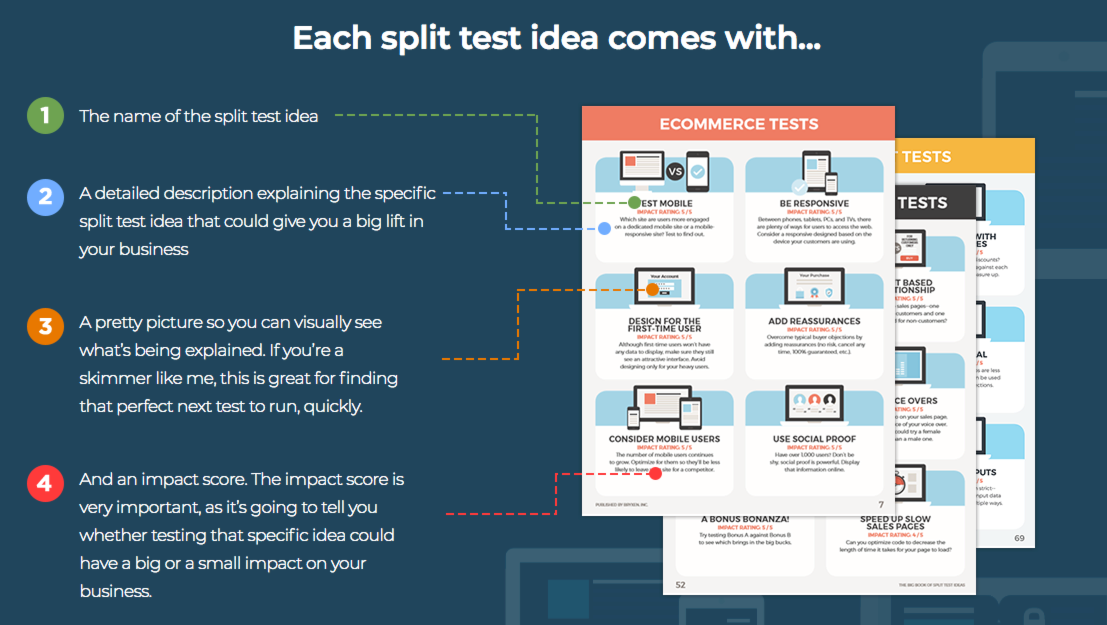A split test is a process of measuring your results against at least two different actions or options.
For example, you may send an email with two different subjects to a small group of your subscribers and then whichever one generates the best results, you use that one as the subject when sending that email to the remaining subscribers.
Another example of a split test could be changing up the call to action on a specific button on your website.
One specific test I’ve done in the past that lead to better results, was to change my email subscription button from “Subscribe” to “Join Now!”.
What can you split test?
This is a short list of things you can run split test on.
- Complete website page
- Titles
- Buttons (text and/or color)
- Email Subjects
- Order options
- Video or no video
- Images
- Ad copy
- Free or paid
- Social media post
- Direct mail ads
- Landing page design
- Testimonial placement
- Pricing
Again, this is not a complete list, it is however a list of commonly tested things. Some of which I test regularly.
Who should do split test?
The real simple answer is anybody that wants to improve their results!
How else do you know how well something is performing unless you test it!?
- Could you have gotten more opens with a different subject?
- Is it possible that a different image or shorter video would improve the click through if you Facebook ad?
- Would your blog post have a smaller bounce rate if the title was different?
- Is it possible for your website to produce more qualified leads with a different call to action on the home page?
- Does your website need a completely new homepage?
These are questions you can get answers to with split test campaigns. No more leaving money on the table!
How I come up with split test ideas
I have five resources I use regular for split test ideas. I’ll break each of these down, what they are and how I use them.
- 108 Proven Split Test Winners (free book)
- The Big Book of Split Test Ideas (free book)
- Adespresso (Facebook Ads)
- Analytics
- Modeling
108 Proven Split Test Winners
The thing I love about this book and why it’s my first go-to, is because it shows actual split test and the outcomes. The author provides context and details of the test and shows the winner. They even go so far as to show you how much improvement the test resulted in.
Here is an example from the book.
Did you spot the difference? It’s a simple one. The only change was in the description of the final step.
The Big Book of Split Test Ideas
 This is a newer resource for me, but it has been awesome! I original expected it to be more like the first book, where it actually showed the test pages and the results. Although this one is different, it is still crazy helpful.
This is a newer resource for me, but it has been awesome! I original expected it to be more like the first book, where it actually showed the test pages and the results. Although this one is different, it is still crazy helpful.
This book offers more ideas then strategy. It’s broken into 13 different categories like:
- Ecommerce
- Facebook Ads
- Social Media
- Website Navigation
- and more
Here is an outline of what is available in the book for each of the ideas.

Adespresso
 This site is dedicated to improving your knowledge and success with Facebook Ads. You will see examples of ads from different industries. These ads don’t show results, but they will give you a few good ideas of what people are doing in your industry and things you can try.
This site is dedicated to improving your knowledge and success with Facebook Ads. You will see examples of ads from different industries. These ads don’t show results, but they will give you a few good ideas of what people are doing in your industry and things you can try.
There are over 148k ads on this site. They also have guides, ebooks, webinars, and courses. Some free and some paid, but if you decide to join their university it’s only $19/mo, but you can browse the ads for free.
Analytics
 I use WordPress.com or Jetpack analytics and Google Analytics on all my sites. The reason I like to use both is because Google doesn’t display keyword searches and Jetpack stats does show some keyword searches.
I use WordPress.com or Jetpack analytics and Google Analytics on all my sites. The reason I like to use both is because Google doesn’t display keyword searches and Jetpack stats does show some keyword searches.
Keyword searches show exactly how people are finding your content.
But there are also a lot of other great reasons to use it.
Jetpack stats is powerful for the individual post tracking. I can see stats about how many views in a day, how many likes, and how many comments.
The reason this is so important is because I use that data to help me know which of my post are most relevant to my audience. With that knowledge, I can create more of that content.

Modeling
Modeling is when you look at your competitors or someone else in your space and see what they’re doing. Then try to determine if it’s working, if you come to the conclusion that it is working, or at least if you think it’s worth trying, then you try it.
This is a simple process. Avoid copying exactly what they’re doing. But model it as closely as you can.
I do this often with Facebook ads and website layouts.
Every time I see an ad on Facebook that I think would work for my audience, I take a screen shot.
This website, the homepage, I modeled after someone who I know is successful at what I want to do.

There are a ton of successful websites sales funnels that you can model from Russell Brunson, founder of Click Funnels. His most popular is the free plus shipping book funnel. This funnel has made him millions of dollars and is used by people all the time.
The Wrap Up
You’ve got to measure and test the things that matter. If you’re spending money or time on something, it matters!
If you want to get the best return from your efforts and dollars, you need to test. These split test resources will help you start doing that correctly.
If you have any questions or need someone to review your ads, website, titles, emails, etc, use the comments or email me.
Bonus Section
If you’ve read this far, or at least scrolled to the bottom, thank you and congrats, because I have a bonus hack for you.
If you want a free and simple way to test you blog post titles or ad headlines before running ads, use social media.
Schedule several post in as many social accounts as you have, in your copy, change up the “headline” of that post. See which one gets the best results, then use that one.
I recommend at least four different post for each social account. I user Buffer.com for this, they have a free plan.
If you don’t have very many followers or not very active followers, try using hashtags in each of the post, but make sure those hashtags relate to the audience you want to target with your ad or post.
Using the hashtags will also give you some idea as to which target market prefers which copy. That will help with building out your audience in your Facebook ads.





